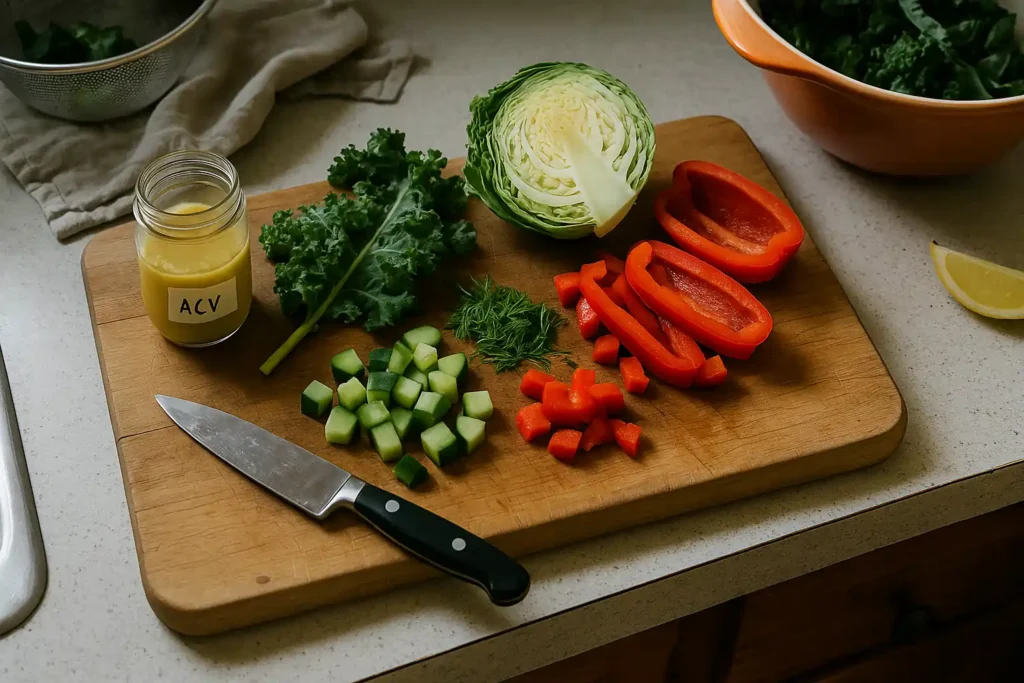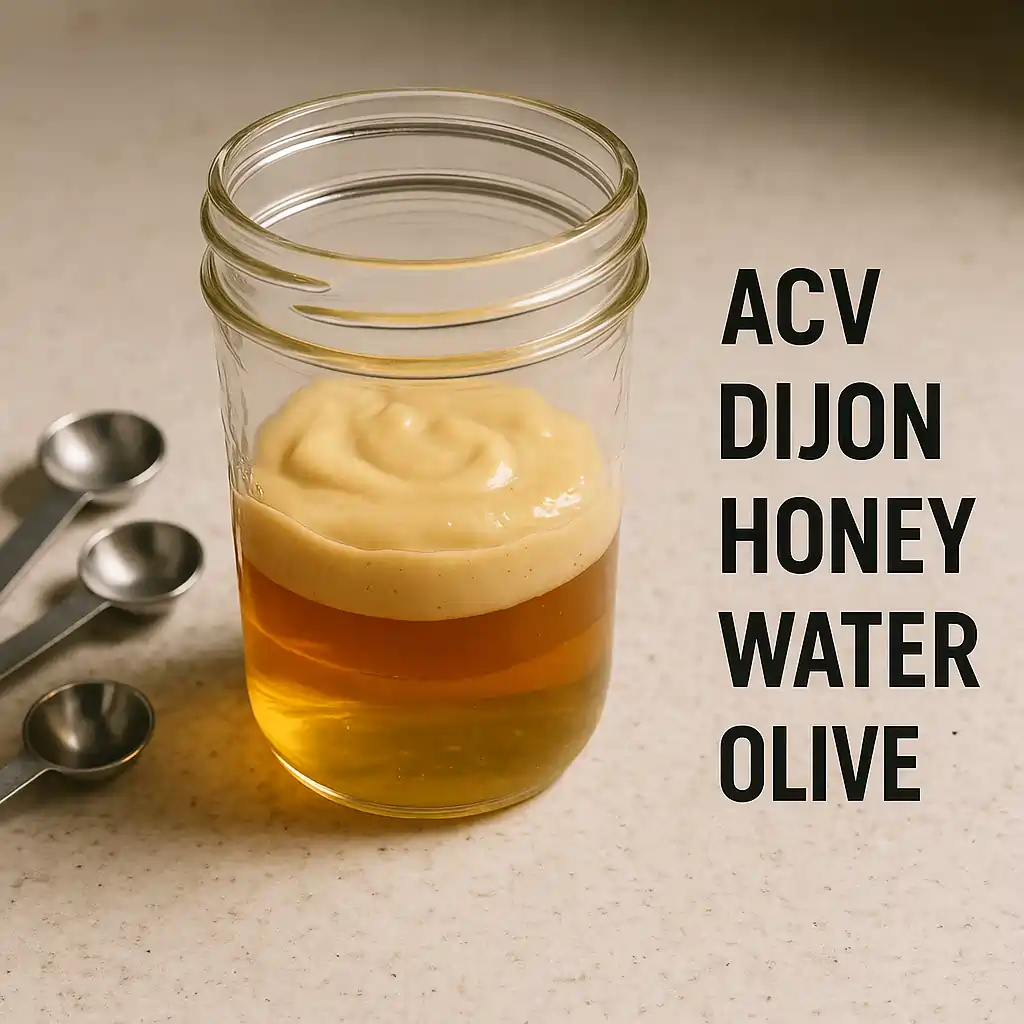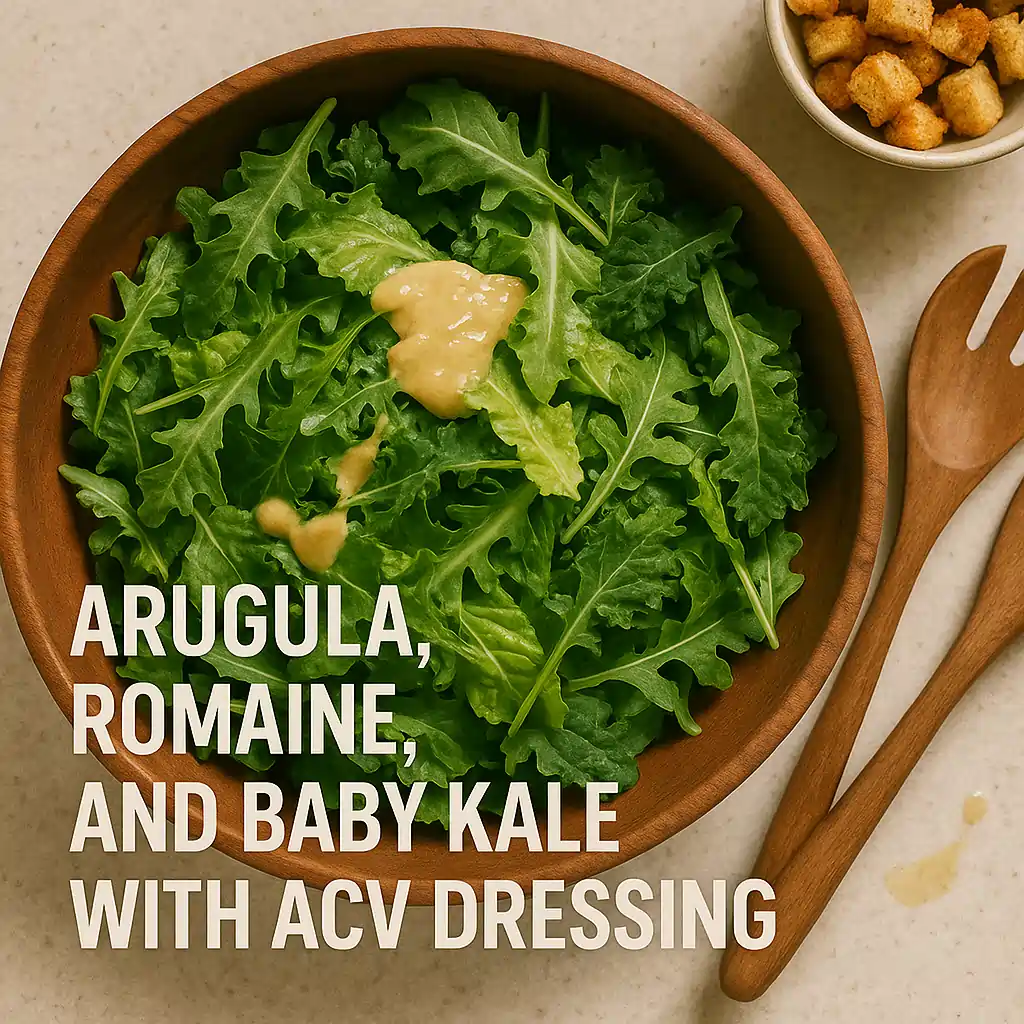“Learn one ratio and you’ll never need another dressing.” That line hooked me years ago, and ACV made it make sense fast. This apple cider vinegar salad dressing is bright, balanced, and done in minutes—perfect when dinner’s already yelling at you from the cutting board.
I love ACV because it’s tangy but friendly. It gives that restaurant snap without needing a pile of ingredients, and it plays nice with fruit, grains, and crunchy veg. When I first tried it, I made a face—too sharp, too pickly—and then I learned two tiny fixes that changed everything.

Table of Contents
Table of Contents
Why ACV works
Apple cider vinegar carries malic acid, so it tastes rounder than plain white vinegar. That means you can push a slightly tighter oil-to-acid ratio and still land on smooth. It’s also got that apple note that whispers “fresh” even before greens hit the bowl.
The magic move is pairing ACV with Dijon and a little water. Dijon helps the vinaigrette cling like a pro, and water lightens the mouthfeel so it coats leaves without drowning them. Once I started tasting on a salad leaf—not a spoon—my tweaks got calm and precise instead of wild guesses.
Flavor-wise, ACV loves honey, maple, or even a mashed strawberry if you’re feeling playful. It also high-fives shallot, black pepper, and herbs like dill and parsley. When a dressing tastes flat, I add a tiny squeeze of lemon to brighten the top note and suddenly it sings.
Base recipe (classic ACV vinaigrette)

Here’s the base recipe I make on autopilot. In a small jar, I combine three tablespoons apple cider vinegar, one teaspoon Dijon, a pinch of fine salt or none if you’re cutting back, and optional one to two teaspoons honey for roundness. I add two tablespoons cold water, then pour in six tablespoons extra-virgin olive oil and shake hard for 20 seconds.
Taste on a leaf. If it’s too sharp, add one more tablespoon water or another teaspoon oil and shake again. If it’s sleepy, crack in fresh black pepper or a squeeze of lemon and it wakes right up.
This sits between a 2:1 and 3:1 vibe once the water joins the party, which is why it feels light but still glossy. For meal prep, I double the batch and label the lid so future-me remembers what’s inside. If it splits in the fridge, no drama—just shake like you mean it.
Apple Cider Vinegar Salad Dressing
Equipment
- small jar with lid
- measuring spoons
- small whisk or fork (optional)
- citrus juicer (if using lemon)
Ingredients
- 3 tbsp apple cider vinegar
- 1 tsp Dijon mustard
- 1 pinch fine salt (optional)
- 2 tsp honey (optional)
- 2 tbsp cold water
- 6 tbsp extra-virgin olive oil
- 1 pinch black pepper (optional)
- 1 tsp lemon juice (optional, for brightness)
Instructions
- In a jar, combine apple cider vinegar, Dijon mustard, salt (if using), and honey (if using). Add cold water and whisk or shake until blended.
- Pour in olive oil, seal the jar, and shake hard for 20 seconds until emulsified and glossy.
- Taste on a salad leaf. Adjust sharpness with water, add lemon for lift, or black pepper for warmth.
- Store in the fridge for 1–2 weeks. Shake before using. If oil firms up, let it sit at room temp or run under lukewarm water.
Notes
- Use honey or maple for a sweet twist, or go sugar-free with shallot and nutritional yeast.
- Add lemon for brightness, or yogurt/tahini for creaminess.
- Shake well before use and taste on greens, not a spoon, for best balance.
No-honey option (sugar-free)
When I skip sweeteners, I adjust texture and aroma instead of chasing sugar. I keep the ACV at three tablespoons, whisk in a full teaspoon of Dijon, and add three tablespoons water so the acidity doesn’t poke. Then I fold in a tablespoon very finely minced shallot and let it sit in the vinegar for five minutes before adding oil.
That quick maceration softens the bite and builds “perceived” sweetness without actual sugar. If you like, a few drops of liquid stevia work, but it’s optional and easy to overdo. For deep savory, I sometimes add a half teaspoon nutritional yeast and grin because it tastes richer than it should.
I used to overcorrect with oil and end up greasy. Now I fix sharpness with water first, then salt last, and I’m done. It’s faster, cheaper, and honestly smarter.
Creamy twist (yogurt or tahini)
Creamy ACV dressing scratches that ranch itch without heavy mayo. I whisk a third cup plain Greek yogurt with two tablespoons ACV, one tablespoon lemon, one teaspoon Dijon, and two tablespoons water, then stream in two tablespoons olive oil until it turns silky. Dill and chives jump in, and a tiny garlic note if you roll that way.
For dairy-free, tahini is a total champ. I stir three tablespoons tahini with two tablespoons ACV, two tablespoons warm water, one teaspoon Dijon, and one tablespoon olive oil until smooth. It tastes nutty, bright, and clings beautifully to chopped salads and grain bowls.
If either version feels too thick, add water by the tablespoon and stop the instant it pours like light cream. If it tastes shy, a squeeze of lemon or an extra grind of pepper lifts the whole thing. Small tweaks, big payoff.
Pairings (greens, slaws, grains)

ACV vinaigrette loves crisp, slightly bitter greens. I reach for romaine, arugula, or baby kale when I want crunch and contrast, and it absolutely slaps on spinach with sliced apples and toasted walnuts. If you toss early, go lighter than you think, then add a touch more right before serving.
For slaws, it’s a natural. Shredded cabbage, carrots, and a spoon of raisins get shiny and bright, and the water-thinned texture means no gloopy mayo vibes. I add pumpkin seeds for pop and a sprinkle of black pepper that makes it taste bistro-ish.
Grains are where ACV quietly wins dinner. Warm farro or quinoa drinks it up without turning soggy, and leftover roasted veggies feel brand-new with a drizzle. Chickpeas or shredded chicken jump in, and suddenly you’ve got a bowl that eats like a meal, not a side.
Storage
Classic ACV vinaigrette keeps well in the fridge for about one to two weeks. I write the date on the lid and thank past-me later. If you added fresh garlic or herbs, I try to finish in three to five days so flavor stays bright.
Olive oil may firm up when cold, so I set the jar on the counter for ten minutes or run it under lukewarm water. Then I shake hard and it comes right back together. I skip the microwave, because hot spots can split a creamy version and dull the vinegar.
Separation isn’t failure—it’s normal. A vigorous shake fixes it, and if it stays fussy, whisk in a half teaspoon Dijon in a small bowl and slowly stream the broken dressing into it. Boom, glossy again.
Serving ideas & quick riffs
For a fast “house” version, add a pinch of dried oregano and a little grated Parmesan at the table. For a sweet-tart note, swap a teaspoon of the oil for a teaspoon of maple, or toss in a few crushed raspberries for date-night pink. A micro drizzle of toasted sesame oil steers it toward slaw and rice bowls in two seconds flat.
When you’re avoiding added sugar entirely, the tweaks in Sugar-Free Salad Dressing (No Added Sweeteners) plug right into this formula. And for the bigger ratio playbook (plus more swaps), the hub at My Guide to Salad Dressing keeps your options wide open.
I once dumped too much ACV and thought the batch was toast. One tablespoon water and a pea of Dijon later, it was perfect, and I actually laughed at myself. Tiny fixes, huge wins.
Step-by-step recap (5 minutes)
Jar, vinegar, Dijon, water, sweetener if using, aromatics, then oil. Shake hard. Taste on a leaf and adjust with water for sharpness, lemon for lift, or pepper for warmth.
Dress right before eating if your greens are delicate, or lightly ahead if you’re working with slaw or grains. Save a spoonful to finish at the table because it tastes fresher, and yes, that last drizzle makes people think you’re fancy. You’re welcome.
Conclusion
ACV vinaigrette is the little black dress of salads—simple, flattering, and ready for anything. Learn this base, then riff creamy, go sugar-free, or steer it toward grains and slaws, and you’ve basically got a weeknight superpower. If you tweak it, tell me what worked (or flopped) in the comments so we can steal your genius and make dinner even better tomorrow.
